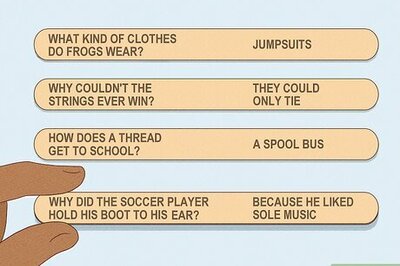
views
FLAGSTAFF, Arizona: Near the end, Howard Smith spent every moment he could with his wife of 50 years as she lay dying from complications of Alzheimer’s disease in an upstate New York nursing home.
For 12 days last month, Howard and the couple’s daughter, Laurel Smith, kept vigil at Lois Kittson’s bedside at the New Paltz Center in the Hudson River Valley, sometimes spending fitful nights slouched on a chair in her room.
During the first of these visits, Lois, 78, was cognizant, opening her eyes, acknowledging their presence, even smiling though she could no longer speak. When Lois’ organs began failing and she could no longer swallow, Howard wet her tongue with cool water every so often to keep her comfortable. A renowned artist, he painted watercolors by her bedside.
There was music, too, meant to soothe Lois through her final days. The visitors often played two CDs: flute sonatas by Bach, which they thought might evoke memories of Laurel’s own beautiful playing back in her youth; and violin pieces by Beethoven, including “Spring Sonata,” one of Lois’ favorites.
Howard was there, holding Lois’ hand, when her breathing speeded up on the morning of August 28 and when, hours later, it stopped.
He commended the facility’s staff for providing his wife with stellar care but said that being unable to visit her had been wrenching.
“For months we hadn’t been able to see Lois except through a digital screen, which really meant very little to her,” Howard said. “So these final visits, while sad, were quite beautiful.”
Reuters first wrote about Howard and Lois in April. Their story showed how the pandemic, and resulting nursing home lockdowns, had broken their years-long routine of near-daily visits together, a ritual that was central to the couple’s lives. Lois had been diagnosed with Alzheimer’s a decade ago and spent the last five years at the nursing home with advancing disability and dementia.
Between March 11 and last month, Howard had rarely been allowed to see his wife in person, including a brief outdoor visit in June.
More than six months into a pandemic that has claimed more than 190,000 American lives, much of the country has now reopened for business. Precautions such as social distancing and mask-wearing remain, but for most Americans, strict lockdowns are over.
At many nursing homes, however, lockdowns remain in force. The final days that Lois, Howard and Laurel spent together highlight how, in facilities that have been the site of more than 40% of the country’s COVID-19 deaths, routines are still anything but normal. In many cases, loved ones are still kept out unless a resident is near death.
Visitation bans are meant to protect vulnerable residents against the virus. In New York alone, there have been more than 6,000 COVID-19 deaths at the state’s care homes. Health data shows a decline in virus cases at the facilities in recent months.
To be with Lois during her final days, Howard and Laurel Smith were required to make use of one of the only in-person visitation options currently available at Lois’ nursing home, the so-called “end of life” provision.
Reopening nursing homes to regular family visits is proving a slow and complicated process nationwide. “It’s not just ‘open the door and let ’em back in,’” said Dee Pekruhn, a policy director at LeadingAge, a group that represents nonprofit senior service providers. “Closing down was the easy part, and opening up is the hard part.”
On August 17, Howard got a call from Lois’ nursing home informing him that she had entered the end-of-life phase. This meant family members were allowed to visit and say goodbye.
Howard rushed to her bedside the same day. Laurel, who works in the tech sector and lives in Manhattan, arrived soon after.
“We know she died peacefully, and I don’t think my dad would ever have recovered had he not been able to get in there,” Laurel said.
Six days a week for the past five years, Howard visited Lois to keep her alive. For 12 days last month, he visited Lois to help her die.

















Comments
0 comment